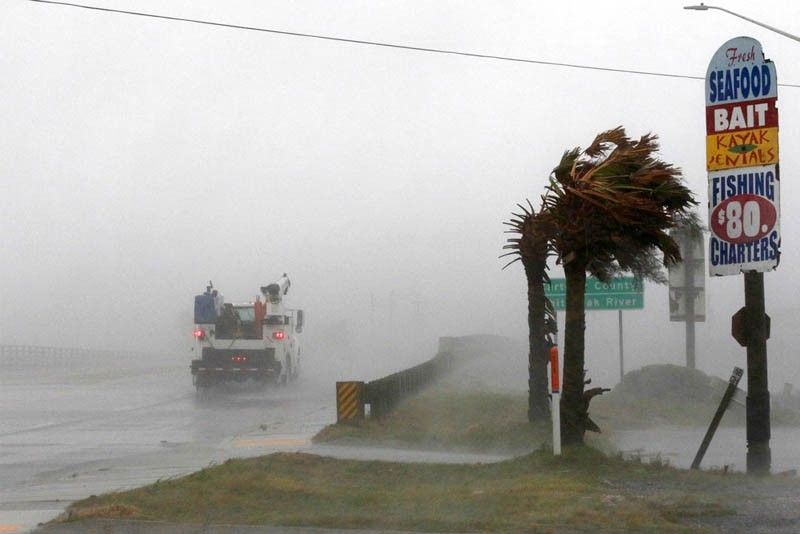4 dead as Hurricane Florence drenches the Carolinas

WILMINGTON, N.C. — Blowing ashore with howling 90 mph (155 kph) winds, Florence splintered buildings, trapped hundreds of people and swamped entire communities along the Carolina coast Friday in what could be just the opening act in a watery, two-part, slow-motion disaster. At least four people were killed.
Forecasters warned that drenching rains of 1 to 3½ feet (30 centimeters to 1 meter) as the hurricane-turned-tropical storm crawls westward across North and South Carolina could trigger epic flooding well inland over the next few days.
As 400-mile-wide (645-kilometer-wide) Florence pounded away at the coast with torrential downpours and surging seas, rescue crews used boats to reach more than 360 people besieged by rising waters in New Bern, while many of their neighbors awaited help. More than 60 people had to be rescued in another town as a cinderblock motel collapsed at the height of the storm's fury.
Florence flattened trees, crumbled roads and the assault wasn't anywhere close to being over, with the siege in the Carolinas expected to last all weekend. The storm knocked out power to more than 890,000 homes and businesses, according to poweroutage.us, which tracks the U.S. electrical grid.
North Carolina Gov. Roy Cooper called Florence an "uninvited brute" that could wipe out entire communities as it grinds across the state.
"The fact is this storm is deadly and we know we are days away from an ending," Cooper said. Parts of North Carolina had seen storm surges — the bulge of seawater pushed ashore by the hurricane — as high as 10 feet (3 meters), he said.
A mother and baby were killed when a tree fell on a house, according to a tweet from Wilmington police. Also, a 77-year-old man was apparently knocked down by the wind and died after going out to check on his hunting dogs, Lenoir County authorities said, and the governor's office said a man was electrocuted while trying to connect extension cords in the rain.
Shaken after seeing waves crashing on the Neuse River just outside his house in New Bern, restaurant owner and hurricane veteran Tom Ballance wished he had evacuated.
"I feel like the dumbest human being who ever walked the face of the earth," he said.
After reaching a terrifying Category 4 peak of 140 mph (225 kph) earlier in the week, Florence made landfall as a Category 1 hurricane at 7:15 a.m. at Wrightsville Beach, a few miles (kilometers) east of Wilmington and not far from the South Carolina line. It came ashore along a mostly boarded-up, emptied-out stretch of coastline.
By Friday evening, Florence was downgraded to a tropical storm, its winds weakened to 70 mph (112 kph) as it moved forward at 3 mph (6 kph) about 15 miles (25 kilometers) north of Myrtle Beach, South Carolina.
But it was clear that this was really about the water, not the wind. Several places already had more than 16 inches (40 centimeters) of rain, and Oriental, North Carolina got more than 20 inches (50 centimeters) in just a few hours.
Florence's forward movement during the day slowed to a near-standstill — sometimes it was going no faster than a human can walk — and that enabled it to pile on the rain.
The flooding soon spread into South Carolina, swamping places like North Myrtle Beach, in a resort area known for its white sands and multitude of golf courses.
For people living inland in the Carolinas, the moment of maximum peril from flash flooding could arrive days later, because it takes time for rainwater to drain into rivers and for those streams to crest.
Preparing for the worst, about 9,700 National Guard troops and civilians were deployed with high-water vehicles, helicopters and boats.
Authorities warned, too, of the threat of mudslides and the risk of an environmental disaster from floodwaters washing over industrial waste sites and hog farms.
Florence was seen as a major test for the Federal Emergency Management Agency, which was heavily criticized as slow and unprepared last year for Hurricane Maria in Puerto Rico, where the death toll was put at nearly 3,000.
The National Hurricane Center said Florence will eventually break up over the southern Appalachians and make a right hook to the northeast, its rainy remnants moving into the mid-Atlantic states and New England by the middle of next week.
Meteorologist Ryan Maue of weathermodels.com said Florence could dump a staggering 18 trillion gallons (68 trillion liters) of rain over a week on North Carolina, South Carolina, Virginia, Georgia, Tennessee, Kentucky and Maryland. That's enough to fill the Chesapeake Bay or cover the entire state of Texas with nearly 4 inches (10 centimeters) of water, he calculated.
North Carolina alone is forecast to get 9.6 trillion gallons (36 trillion liters), enough to cover the Tar Heel state to a depth of about 10 inches (25 centimeters).
On Friday, coastal streets in the Carolinas flowed with frothy ocean water, and pieces of torn-apart buildings flew through the air. The few cars out on a main street in Wilmington had to swerve to avoid fallen trees, metal debris and power lines.
A wind gust at the Wilmington airport was clocked at 105 mph (nearly 170 kph), the highest since Hurricane Helene in 1958. Nationwide, airlines canceled more than 2,400 flights through Sunday.
In Jacksonville, North Carolina, next to Camp Lejeune, firefighters and police fought wind and rain as they went door-to-door to pull dozens of people out of the Triangle Motor Inn after the structure began to crumble and the roof started to collapse.
In New Bern, population 29,000, flooding on the Neuse River left 500 people in peril.
"WE ARE COMING TO GET YOU," the city tweeted around 2 a.m. "You may need to move up to the second story, or to your attic, but WE ARE COMING TO GET YOU."
Boat teams including volunteers rescued some 360 residents, including Sadie Marie Holt, 67, who first tried to row out of her neighborhood during Florence's assault.
"The wind was so hard, the waters were so hard, that trying to get out we got thrown into trailers. We got thrown into mailboxes, houses, trees," said Holt, who had stayed at home because of a doctor's appointment that was later canceled. She retreated and was eventually rescued by a boat crew; 140 more awaited assistance.
Ashley Warren and boyfriend Chris Smith managed to paddle away from their home in a boat with their two dogs, and the experience left her shaken.
"Honestly, I grew up in Wilmington. I love hurricanes. But this one has been an experience for me," she said. "We might leave."
- Latest
- Trending































